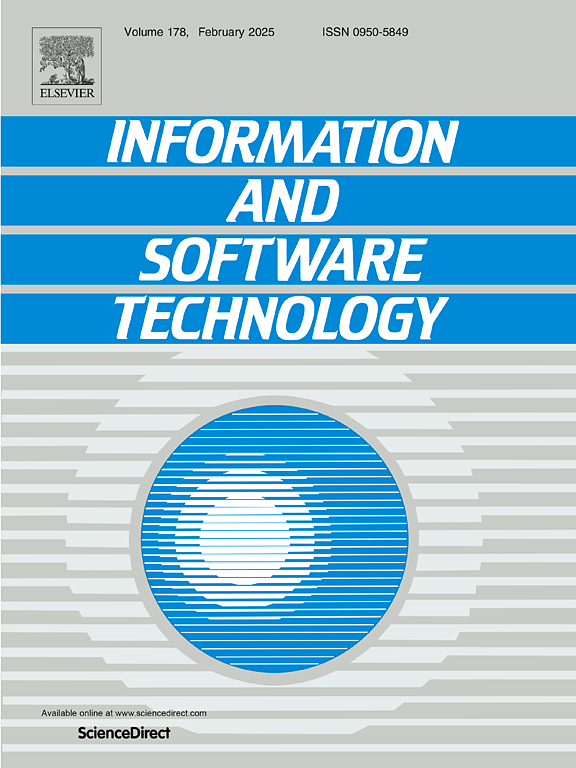Reengineering software systems into microservices: State-of-the-art and future directions
IF 4.3
2区 计算机科学
Q2 COMPUTER SCIENCE, INFORMATION SYSTEMS
引用次数: 0
Abstract
Context:
With the acknowledged benefits of microservices architectures, such as scalability, flexibility, improved maintenance, and deployment, legacy software systems are increasingly being reengineered into microservices. Recently, a plethora of methods, techniques, tools, and evaluation criteria for reengineering software systems into microservices have been proposed without being systematized.
Objectives:
The objective of this work is to conduct an in-depth systematic literature review to identify and analyze methods, techniques, and tools for reengineering software systems into microservices and the ways for evaluating such reengineering initiatives and their results.
Methods:
A systematic literature review of works on reengineering software systems into microservices was performed, yielding 117 primary studies. The review focused on addressing key research questions concerning the evolution of microservices reengineering, methodologies employed, tools available, and the challenges faced in the reengineering process. We used a taxonomy development method to systematize knowledge in these areas.
Results:
The analysis revealed multiple reengineering approaches: static, dynamic, hybrid, and artifact-driven. Significant evaluation criteria identified include coupling, cohesion, and modularity. Key paradigms for microservices reengineering, such as domain-driven design and interface analysis, were identified and discussed. The study also highlights that incremental and iterative transitions are favored in practice.
Conclusion:
This study provides a structured overview of the current state of research on reengineering software systems into microservices. It highlights challenges in existing reengineering methodologies. Future directions include validating behavioral equivalence of original and reengineered systems, automating microservices generation, and refining database layer partitioning. The findings emphasize the need for further work to enhance the reengineering process and evaluation of the transition between monolithic and microservices architectures.
将软件系统重新设计为微服务:最新技术和未来方向
上下文:随着微服务架构的公认优势,如可伸缩性、灵活性、改进的维护和部署,遗留软件系统越来越多地被重新设计为微服务。最近,提出了大量的方法、技术、工具和评估标准,将软件系统重新设计为微服务,但没有系统化。目标:这项工作的目标是进行深入的系统文献综述,以识别和分析将软件系统重新设计为微服务的方法、技术和工具,以及评估此类重新设计计划及其结果的方法。方法:对软件系统再造为微服务的工作进行了系统的文献回顾,产生了117项初步研究。这篇综述的重点是解决有关微服务再工程的演变、采用的方法、可用的工具以及再工程过程中面临的挑战的关键研究问题。我们使用分类法开发方法将这些领域的知识系统化。结果:分析揭示了多种再造方法:静态的、动态的、混合的和工件驱动的。确定的重要评估标准包括耦合、内聚和模块化。识别并讨论了微服务再造的关键范式,如领域驱动设计和接口分析。该研究还强调了增量和迭代转换在实践中更受欢迎。结论:本研究对软件系统再造为微服务的研究现状进行了结构化概述。它突出了现有再造方法中的挑战。未来的方向包括验证原始系统和重新设计系统的行为等价性,自动化微服务生成,以及细化数据库层分区。研究结果强调,需要进一步开展工作,以加强单片和微服务架构之间转换的再工程流程和评估。
本文章由计算机程序翻译,如有差异,请以英文原文为准。
求助全文
约1分钟内获得全文
求助全文
来源期刊

Information and Software Technology
工程技术-计算机:软件工程
CiteScore
9.10
自引率
7.70%
发文量
164
审稿时长
9.6 weeks
期刊介绍:
Information and Software Technology is the international archival journal focusing on research and experience that contributes to the improvement of software development practices. The journal''s scope includes methods and techniques to better engineer software and manage its development. Articles submitted for review should have a clear component of software engineering or address ways to improve the engineering and management of software development. Areas covered by the journal include:
• Software management, quality and metrics,
• Software processes,
• Software architecture, modelling, specification, design and programming
• Functional and non-functional software requirements
• Software testing and verification & validation
• Empirical studies of all aspects of engineering and managing software development
Short Communications is a new section dedicated to short papers addressing new ideas, controversial opinions, "Negative" results and much more. Read the Guide for authors for more information.
The journal encourages and welcomes submissions of systematic literature studies (reviews and maps) within the scope of the journal. Information and Software Technology is the premiere outlet for systematic literature studies in software engineering.
 求助内容:
求助内容: 应助结果提醒方式:
应助结果提醒方式:


